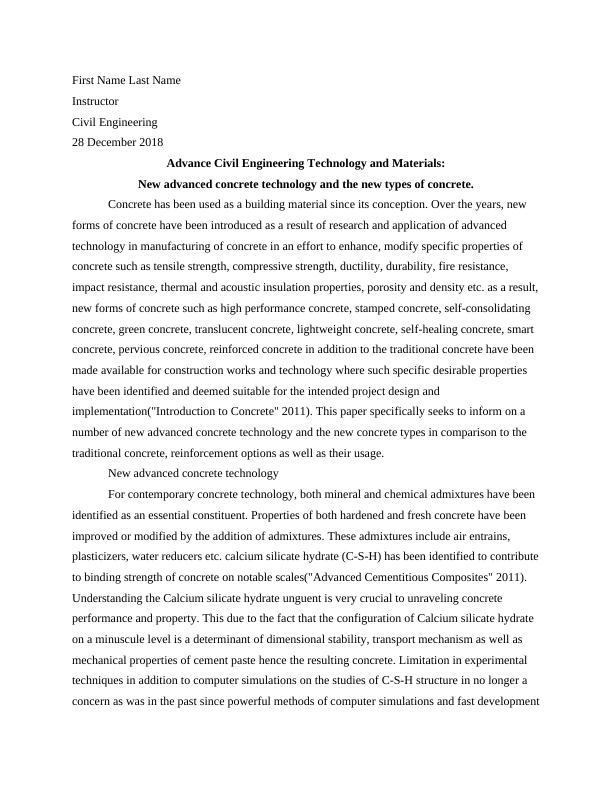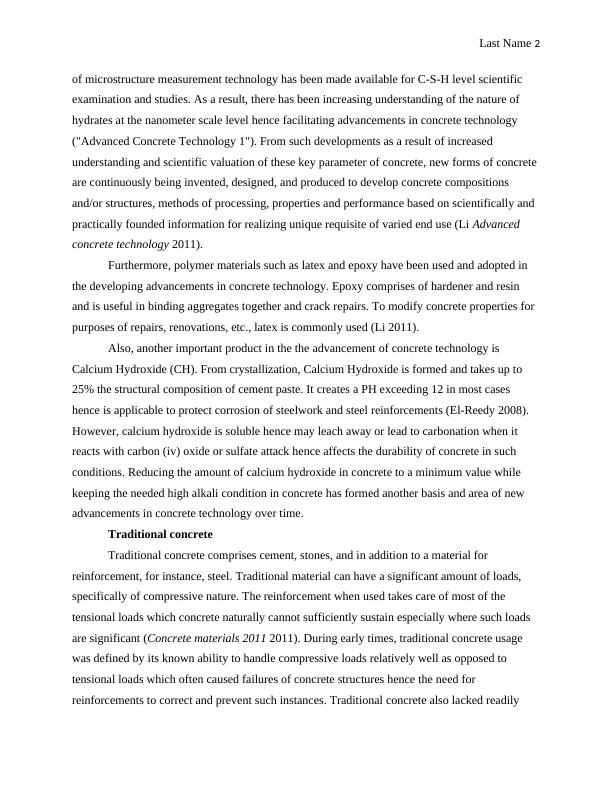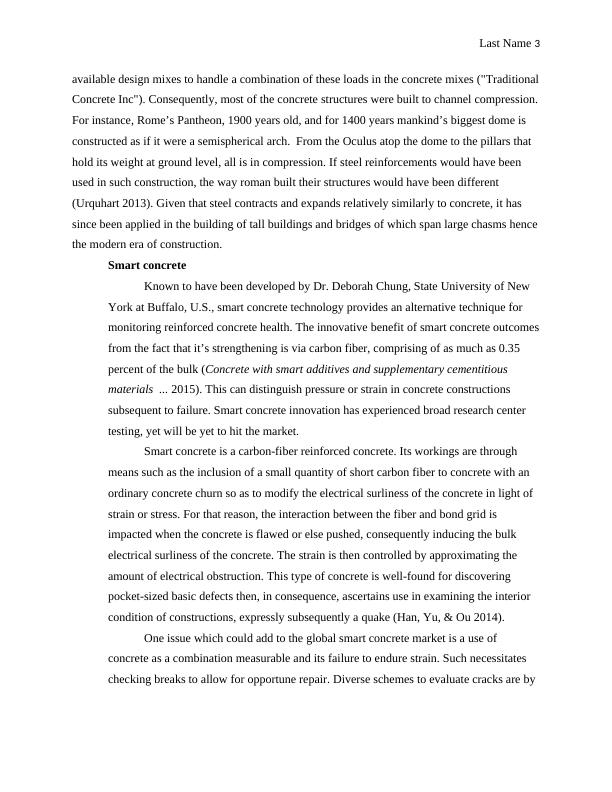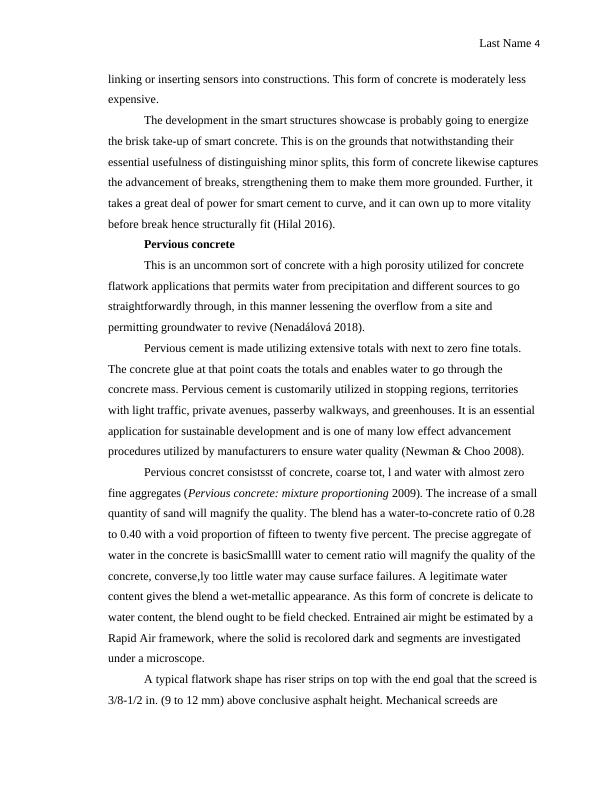New Advanced Concrete Technology and Types of Concrete
11 Pages3719 Words389 Views
Added on 2023-04-21
About This Document
This paper discusses the new advanced concrete technology and various types of concrete compared to traditional concrete. It covers the properties, usage, and advancements in concrete technology, including mineral and chemical admixtures, polymer materials, and calcium hydroxide. It also explores smart concrete, pervious concrete, and self-healing concrete. The aim is to provide information on the advancements in concrete technology and their applications.
New Advanced Concrete Technology and Types of Concrete
Added on 2023-04-21
ShareRelated Documents
First Name Last Name
Instructor
Civil Engineering
28 December 2018
Advance Civil Engineering Technology and Materials:
New advanced concrete technology and the new types of concrete.
Concrete has been used as a building material since its conception. Over the years, new
forms of concrete have been introduced as a result of research and application of advanced
technology in manufacturing of concrete in an effort to enhance, modify specific properties of
concrete such as tensile strength, compressive strength, ductility, durability, fire resistance,
impact resistance, thermal and acoustic insulation properties, porosity and density etc. as a result,
new forms of concrete such as high performance concrete, stamped concrete, self-consolidating
concrete, green concrete, translucent concrete, lightweight concrete, self-healing concrete, smart
concrete, pervious concrete, reinforced concrete in addition to the traditional concrete have been
made available for construction works and technology where such specific desirable properties
have been identified and deemed suitable for the intended project design and
implementation("Introduction to Concrete" 2011). This paper specifically seeks to inform on a
number of new advanced concrete technology and the new concrete types in comparison to the
traditional concrete, reinforcement options as well as their usage.
New advanced concrete technology
For contemporary concrete technology, both mineral and chemical admixtures have been
identified as an essential constituent. Properties of both hardened and fresh concrete have been
improved or modified by the addition of admixtures. These admixtures include air entrains,
plasticizers, water reducers etc. calcium silicate hydrate (C-S-H) has been identified to contribute
to binding strength of concrete on notable scales("Advanced Cementitious Composites" 2011).
Understanding the Calcium silicate hydrate unguent is very crucial to unraveling concrete
performance and property. This due to the fact that the configuration of Calcium silicate hydrate
on a minuscule level is a determinant of dimensional stability, transport mechanism as well as
mechanical properties of cement paste hence the resulting concrete. Limitation in experimental
techniques in addition to computer simulations on the studies of C-S-H structure in no longer a
concern as was in the past since powerful methods of computer simulations and fast development
Instructor
Civil Engineering
28 December 2018
Advance Civil Engineering Technology and Materials:
New advanced concrete technology and the new types of concrete.
Concrete has been used as a building material since its conception. Over the years, new
forms of concrete have been introduced as a result of research and application of advanced
technology in manufacturing of concrete in an effort to enhance, modify specific properties of
concrete such as tensile strength, compressive strength, ductility, durability, fire resistance,
impact resistance, thermal and acoustic insulation properties, porosity and density etc. as a result,
new forms of concrete such as high performance concrete, stamped concrete, self-consolidating
concrete, green concrete, translucent concrete, lightweight concrete, self-healing concrete, smart
concrete, pervious concrete, reinforced concrete in addition to the traditional concrete have been
made available for construction works and technology where such specific desirable properties
have been identified and deemed suitable for the intended project design and
implementation("Introduction to Concrete" 2011). This paper specifically seeks to inform on a
number of new advanced concrete technology and the new concrete types in comparison to the
traditional concrete, reinforcement options as well as their usage.
New advanced concrete technology
For contemporary concrete technology, both mineral and chemical admixtures have been
identified as an essential constituent. Properties of both hardened and fresh concrete have been
improved or modified by the addition of admixtures. These admixtures include air entrains,
plasticizers, water reducers etc. calcium silicate hydrate (C-S-H) has been identified to contribute
to binding strength of concrete on notable scales("Advanced Cementitious Composites" 2011).
Understanding the Calcium silicate hydrate unguent is very crucial to unraveling concrete
performance and property. This due to the fact that the configuration of Calcium silicate hydrate
on a minuscule level is a determinant of dimensional stability, transport mechanism as well as
mechanical properties of cement paste hence the resulting concrete. Limitation in experimental
techniques in addition to computer simulations on the studies of C-S-H structure in no longer a
concern as was in the past since powerful methods of computer simulations and fast development

Last Name 2
of microstructure measurement technology has been made available for C-S-H level scientific
examination and studies. As a result, there has been increasing understanding of the nature of
hydrates at the nanometer scale level hence facilitating advancements in concrete technology
("Advanced Concrete Technology 1"). From such developments as a result of increased
understanding and scientific valuation of these key parameter of concrete, new forms of concrete
are continuously being invented, designed, and produced to develop concrete compositions
and/or structures, methods of processing, properties and performance based on scientifically and
practically founded information for realizing unique requisite of varied end use (Li Advanced
concrete technology 2011).
Furthermore, polymer materials such as latex and epoxy have been used and adopted in
the developing advancements in concrete technology. Epoxy comprises of hardener and resin
and is useful in binding aggregates together and crack repairs. To modify concrete properties for
purposes of repairs, renovations, etc., latex is commonly used (Li 2011).
Also, another important product in the the advancement of concrete technology is
Calcium Hydroxide (CH). From crystallization, Calcium Hydroxide is formed and takes up to
25% the structural composition of cement paste. It creates a PH exceeding 12 in most cases
hence is applicable to protect corrosion of steelwork and steel reinforcements (El-Reedy 2008).
However, calcium hydroxide is soluble hence may leach away or lead to carbonation when it
reacts with carbon (iv) oxide or sulfate attack hence affects the durability of concrete in such
conditions. Reducing the amount of calcium hydroxide in concrete to a minimum value while
keeping the needed high alkali condition in concrete has formed another basis and area of new
advancements in concrete technology over time.
Traditional concrete
Traditional concrete comprises cement, stones, and in addition to a material for
reinforcement, for instance, steel. Traditional material can have a significant amount of loads,
specifically of compressive nature. The reinforcement when used takes care of most of the
tensional loads which concrete naturally cannot sufficiently sustain especially where such loads
are significant (Concrete materials 2011 2011). During early times, traditional concrete usage
was defined by its known ability to handle compressive loads relatively well as opposed to
tensional loads which often caused failures of concrete structures hence the need for
reinforcements to correct and prevent such instances. Traditional concrete also lacked readily
of microstructure measurement technology has been made available for C-S-H level scientific
examination and studies. As a result, there has been increasing understanding of the nature of
hydrates at the nanometer scale level hence facilitating advancements in concrete technology
("Advanced Concrete Technology 1"). From such developments as a result of increased
understanding and scientific valuation of these key parameter of concrete, new forms of concrete
are continuously being invented, designed, and produced to develop concrete compositions
and/or structures, methods of processing, properties and performance based on scientifically and
practically founded information for realizing unique requisite of varied end use (Li Advanced
concrete technology 2011).
Furthermore, polymer materials such as latex and epoxy have been used and adopted in
the developing advancements in concrete technology. Epoxy comprises of hardener and resin
and is useful in binding aggregates together and crack repairs. To modify concrete properties for
purposes of repairs, renovations, etc., latex is commonly used (Li 2011).
Also, another important product in the the advancement of concrete technology is
Calcium Hydroxide (CH). From crystallization, Calcium Hydroxide is formed and takes up to
25% the structural composition of cement paste. It creates a PH exceeding 12 in most cases
hence is applicable to protect corrosion of steelwork and steel reinforcements (El-Reedy 2008).
However, calcium hydroxide is soluble hence may leach away or lead to carbonation when it
reacts with carbon (iv) oxide or sulfate attack hence affects the durability of concrete in such
conditions. Reducing the amount of calcium hydroxide in concrete to a minimum value while
keeping the needed high alkali condition in concrete has formed another basis and area of new
advancements in concrete technology over time.
Traditional concrete
Traditional concrete comprises cement, stones, and in addition to a material for
reinforcement, for instance, steel. Traditional material can have a significant amount of loads,
specifically of compressive nature. The reinforcement when used takes care of most of the
tensional loads which concrete naturally cannot sufficiently sustain especially where such loads
are significant (Concrete materials 2011 2011). During early times, traditional concrete usage
was defined by its known ability to handle compressive loads relatively well as opposed to
tensional loads which often caused failures of concrete structures hence the need for
reinforcements to correct and prevent such instances. Traditional concrete also lacked readily

Last Name 3
available design mixes to handle a combination of these loads in the concrete mixes ("Traditional
Concrete Inc"). Consequently, most of the concrete structures were built to channel compression.
For instance, Rome’s Pantheon, 1900 years old, and for 1400 years mankind’s biggest dome is
constructed as if it were a semispherical arch. From the Oculus atop the dome to the pillars that
hold its weight at ground level, all is in compression. If steel reinforcements would have been
used in such construction, the way roman built their structures would have been different
(Urquhart 2013). Given that steel contracts and expands relatively similarly to concrete, it has
since been applied in the building of tall buildings and bridges of which span large chasms hence
the modern era of construction.
Smart concrete
Known to have been developed by Dr. Deborah Chung, State University of New
York at Buffalo, U.S., smart concrete technology provides an alternative technique for
monitoring reinforced concrete health. The innovative benefit of smart concrete outcomes
from the fact that it’s strengthening is via carbon fiber, comprising of as much as 0.35
percent of the bulk (Concrete with smart additives and supplementary cementitious
materials ... 2015). This can distinguish pressure or strain in concrete constructions
subsequent to failure. Smart concrete innovation has experienced broad research center
testing, yet will be yet to hit the market.
Smart concrete is a carbon-fiber reinforced concrete. Its workings are through
means such as the inclusion of a small quantity of short carbon fiber to concrete with an
ordinary concrete churn so as to modify the electrical surliness of the concrete in light of
strain or stress. For that reason, the interaction between the fiber and bond grid is
impacted when the concrete is flawed or else pushed, consequently inducing the bulk
electrical surliness of the concrete. The strain is then controlled by approximating the
amount of electrical obstruction. This type of concrete is well-found for discovering
pocket-sized basic defects then, in consequence, ascertains use in examining the interior
condition of constructions, expressly subsequently a quake (Han, Yu, & Ou 2014).
One issue which could add to the global smart concrete market is a use of
concrete as a combination measurable and its failure to endure strain. Such necessitates
checking breaks to allow for opportune repair. Diverse schemes to evaluate cracks are by
available design mixes to handle a combination of these loads in the concrete mixes ("Traditional
Concrete Inc"). Consequently, most of the concrete structures were built to channel compression.
For instance, Rome’s Pantheon, 1900 years old, and for 1400 years mankind’s biggest dome is
constructed as if it were a semispherical arch. From the Oculus atop the dome to the pillars that
hold its weight at ground level, all is in compression. If steel reinforcements would have been
used in such construction, the way roman built their structures would have been different
(Urquhart 2013). Given that steel contracts and expands relatively similarly to concrete, it has
since been applied in the building of tall buildings and bridges of which span large chasms hence
the modern era of construction.
Smart concrete
Known to have been developed by Dr. Deborah Chung, State University of New
York at Buffalo, U.S., smart concrete technology provides an alternative technique for
monitoring reinforced concrete health. The innovative benefit of smart concrete outcomes
from the fact that it’s strengthening is via carbon fiber, comprising of as much as 0.35
percent of the bulk (Concrete with smart additives and supplementary cementitious
materials ... 2015). This can distinguish pressure or strain in concrete constructions
subsequent to failure. Smart concrete innovation has experienced broad research center
testing, yet will be yet to hit the market.
Smart concrete is a carbon-fiber reinforced concrete. Its workings are through
means such as the inclusion of a small quantity of short carbon fiber to concrete with an
ordinary concrete churn so as to modify the electrical surliness of the concrete in light of
strain or stress. For that reason, the interaction between the fiber and bond grid is
impacted when the concrete is flawed or else pushed, consequently inducing the bulk
electrical surliness of the concrete. The strain is then controlled by approximating the
amount of electrical obstruction. This type of concrete is well-found for discovering
pocket-sized basic defects then, in consequence, ascertains use in examining the interior
condition of constructions, expressly subsequently a quake (Han, Yu, & Ou 2014).
One issue which could add to the global smart concrete market is a use of
concrete as a combination measurable and its failure to endure strain. Such necessitates
checking breaks to allow for opportune repair. Diverse schemes to evaluate cracks are by

Last Name 4
linking or inserting sensors into constructions. This form of concrete is moderately less
expensive.
The development in the smart structures showcase is probably going to energize
the brisk take-up of smart concrete. This is on the grounds that notwithstanding their
essential usefulness of distinguishing minor splits, this form of concrete likewise captures
the advancement of breaks, strengthening them to make them more grounded. Further, it
takes a great deal of power for smart cement to curve, and it can own up to more vitality
before break hence structurally fit (Hilal 2016).
Pervious concrete
This is an uncommon sort of concrete with a high porosity utilized for concrete
flatwork applications that permits water from precipitation and different sources to go
straightforwardly through, in this manner lessening the overflow from a site and
permitting groundwater to revive (Nenadálová 2018).
Pervious cement is made utilizing extensive totals with next to zero fine totals.
The concrete glue at that point coats the totals and enables water to go through the
concrete mass. Pervious cement is customarily utilized in stopping regions, territories
with light traffic, private avenues, passerby walkways, and greenhouses. It is an essential
application for sustainable development and is one of many low effect advancement
procedures utilized by manufacturers to ensure water quality (Newman & Choo 2008).
Pervious concret consistsst of concrete, coarse tot, l and water with almost zero
fine aggregates (Pervious concrete: mixture proportioning 2009). The increase of a small
quantity of sand will magnify the quality. The blend has a water-to-concrete ratio of 0.28
to 0.40 with a void proportion of fifteen to twenty five percent. The precise aggregate of
water in the concrete is basicSmallll water to cement ratio will magnify the quality of the
concrete, converse,ly too little water may cause surface failures. A legitimate water
content gives the blend a wet-metallic appearance. As this form of concrete is delicate to
water content, the blend ought to be field checked. Entrained air might be estimated by a
Rapid Air framework, where the solid is recolored dark and segments are investigated
under a microscope.
A typical flatwork shape has riser strips on top with the end goal that the screed is
3/8-1/2 in. (9 to 12 mm) above conclusive asphalt height. Mechanical screeds are
linking or inserting sensors into constructions. This form of concrete is moderately less
expensive.
The development in the smart structures showcase is probably going to energize
the brisk take-up of smart concrete. This is on the grounds that notwithstanding their
essential usefulness of distinguishing minor splits, this form of concrete likewise captures
the advancement of breaks, strengthening them to make them more grounded. Further, it
takes a great deal of power for smart cement to curve, and it can own up to more vitality
before break hence structurally fit (Hilal 2016).
Pervious concrete
This is an uncommon sort of concrete with a high porosity utilized for concrete
flatwork applications that permits water from precipitation and different sources to go
straightforwardly through, in this manner lessening the overflow from a site and
permitting groundwater to revive (Nenadálová 2018).
Pervious cement is made utilizing extensive totals with next to zero fine totals.
The concrete glue at that point coats the totals and enables water to go through the
concrete mass. Pervious cement is customarily utilized in stopping regions, territories
with light traffic, private avenues, passerby walkways, and greenhouses. It is an essential
application for sustainable development and is one of many low effect advancement
procedures utilized by manufacturers to ensure water quality (Newman & Choo 2008).
Pervious concret consistsst of concrete, coarse tot, l and water with almost zero
fine aggregates (Pervious concrete: mixture proportioning 2009). The increase of a small
quantity of sand will magnify the quality. The blend has a water-to-concrete ratio of 0.28
to 0.40 with a void proportion of fifteen to twenty five percent. The precise aggregate of
water in the concrete is basicSmallll water to cement ratio will magnify the quality of the
concrete, converse,ly too little water may cause surface failures. A legitimate water
content gives the blend a wet-metallic appearance. As this form of concrete is delicate to
water content, the blend ought to be field checked. Entrained air might be estimated by a
Rapid Air framework, where the solid is recolored dark and segments are investigated
under a microscope.
A typical flatwork shape has riser strips on top with the end goal that the screed is
3/8-1/2 in. (9 to 12 mm) above conclusive asphalt height. Mechanical screeds are

End of preview
Want to access all the pages? Upload your documents or become a member.
Related Documents
Nano Silica Incorporated Concrete (Doc)lg...
|36
|7193
|60
